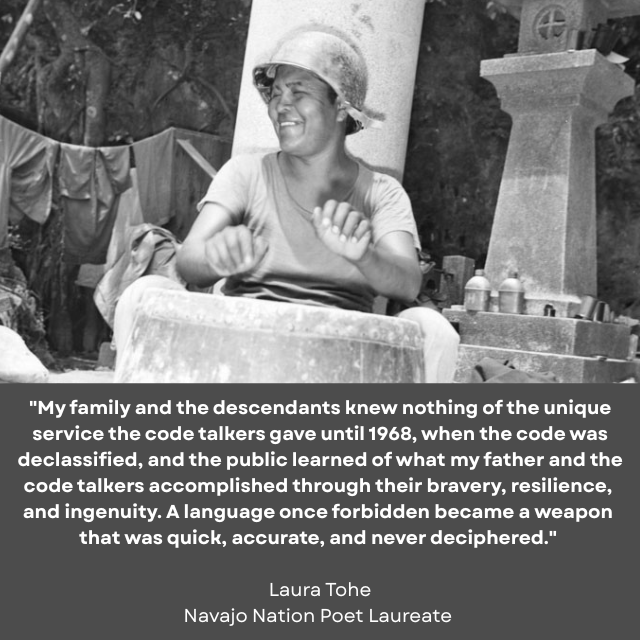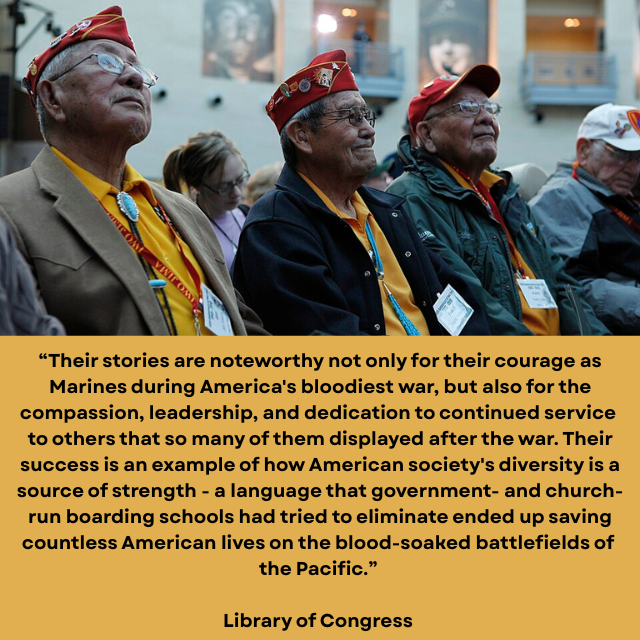- +1 (267) 368-7090
- contact@matcgroup.com
-
53 Knightsbridge Rd,
STE 216
Piscataway, NJ 08854.
We celebrate Navajo Code Talkers Day on 8/14, commemorating their vital contributions during WWII.
During World War II, the U.S. military faced a critical challenge: communicating sensitive military strategies in a way that would be unintelligible to the enemy. The solution came from an unexpected source — the Navajo Code Talkers. This group of Native American men revolutionized the concept of leadership through their unique contributions, highlighting the importance of diversity in military and organizational success.
Code Talkers came from at least 14 Native nations, including the Navajo, Cherokee, and Comanche, serving in both the Pacific and Europe during the war. The Navajo Code Talkers were tasked with creating an unbreakable code based on the Navajo language, which had no written form and was unfamiliar to non-Navajo speakers. The code used words from their language to represent military terms, such as “egg” for “bomb” and “tortoise” for “tank.” This code proved so complex and effective that it was never deciphered by the enemy, becoming one of the most vital communication tools for the Allies during the Pacific campaign.
![Two Navajo Code Talkers communicating over a radio in a jungle environment. Caption reads: "...just six Navajo Code Talkers successfully transmitted over 800 messages without error throughout the duration of the month-long fight. After the battle, a 5th Marine Division signal officer [Major Howard Connor] stated that 'Were it not for the Navajos, the Marines would never have taken Iwo Jima.'" - United States Navy Memorial](https://www.matcgroup.com/wp-content/uploads/2025/07/just-six-Navajo-Code-Talkers-successfully-transmitted-over-800-messages-without-error-throughout-the-duration-of-the-month-lo.png)
While their linguistic skills were essential, the story of the Code Talkers is also one of leadership in diversity. The Navajo Code Talkers didn’t just use their unique language skills; they demonstrated a kind of leadership that went beyond traditional notions of authority and control. Their leadership was rooted in adaptability, community, and the power of cultural difference.
The Navajo Code Talkers exemplified how leveraging diversity within an organization often leads to groundbreaking results. Their ability to harness their cultural strengths, such as language, tradition, and close-knit community bonds, allowed them to tackle a challenge that other military units may have struggled to solve. This type of leadership is grounded in the belief that diverse perspectives lead to innovative solutions.

The success of the Code Talkers was also a testament to the adaptability of Native American traditions in the face of modern challenges. The Code Talkers drew on their understanding of their language and culture to create a solution that was rooted in tradition yet innovative in its application. This blending of old and new exemplifies how leveraging diverse backgrounds and experiences can be key to overcoming complex challenges.
In many ways, the Navajo Code Talkers’ leadership style challenges the conventional view of leadership. They weren’t generals or officers—they were part of a collective effort. The Code Talkers operated in teams, communicating and supporting one another, where each individual’s strengths contributed to the success of the group. Their success was a result of mutual respect, trust, and a shared commitment to their mission.

The legacy of the Navajo Code Talkers transcends their military achievements. Today, their story serves as a powerful reminder of the importance of diversity in leadership. It’s a lesson that extends beyond military service and is applicable to any organization or community striving for success in a complex, interconnected world.
In recent years, the Code Talkers were recognized for their extraordinary contributions, with honors such as the Congressional Gold Medal awarded to the remaining veterans. This recognition is not only a tribute to their military service but also to the broader lessons they teach about leadership, resilience, and the strength that comes from embracing diversity.
The Navajo Code Talkers’ story is one of hidden strengths — strengths that, when embraced and celebrated, reshape the way we view leadership and success. Their legacy continues to inspire those who understand that true leadership doesn’t come from conformity, but from the courage to embrace differences and use them to create something powerful.
Bridging the Gap: Tackling Racial Disparities in Instructional Design
Trailblazers in Education and Training: Women who Shaped L&D and Instructional Design
Women Who Shaped Technical Writing: A History of Progress, Struggles, and Successes
“American Indian Code Talkers.” The National WWII Museum. Accessed 7/11/25. https://www.nationalww2museum.org/war/articles/american-indian-code-talkers
“Navajo Code Talkers: A Guide to First-Person Narratives in the Veterans History Project.” Library of Congress. Accessed 7/11/25. https://guides.loc.gov/navajo-code-talkers
“Talking Code, Honoring Service: Remembering the Navajo Code Talkers.” United States Navy Memorial. 8/14/20. Accessed 7/11/25. https://www.navymemorial.org/tales-from-the-navy-log/2020/8/14/talking-code-honoring-service-remembering-the-navajo-code-talkers
Tohe, Laura. “Code Talkers Were America’s Secret Weapon in World War II.” National Endowment for the Humanities. Summer 2022. Accessed 7/11/25. https://www.neh.gov/article/code-talkers-were-americas-secret-weapon-world-war-ii